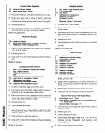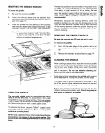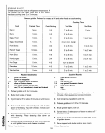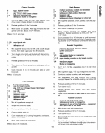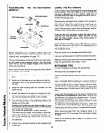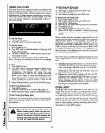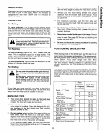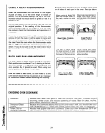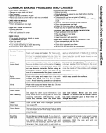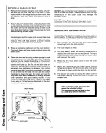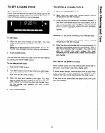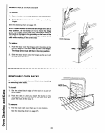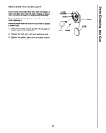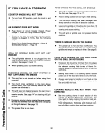
PREHEATING
Preheating lets the oven heat evenly throughout before
the food is put in the oven. Allow 10 minutes at
temperatures less than 350°F and 15 minutes at
350°F or more.
USING FOIL
For Baking
To catch spitlovers, cut a piece of foil slightly larger
than the pan and turn up the edges. Use two oven racks
and put the foil on the lower oven rack below the pan.
Do not use aluminum foil directly under a pan on the
same oven rack. The foil will reflect heat away from the
pan.
A
Do not cover the oven bottom or an entire
oven rack with foil. The foil can block nor-
mal heat flow, cause cooking failures, and
damage the oven interior.
For Roasting
For slow browning, place a foil “tent” loosely over the
meat. This is especially good on a large turkey. The
“tent” lets oven heat circulate under the foil. Sealing
the foil will tend to steam the meat.
To reduce spattering, lightly crush foil and put.it in the
bottom of the pan under the food.
For Broiling
A
Do not cover the entire broiler grid with foil.
Poor drainage of hot fat may cause a broiler
fire.
If a fire starts, close the oven door and push
the OVEN OFF button. If fire continues,
throw baking soda on the fire. Do not put
water or flour on the fire. Flour may be ex-
plosive.
If you feel you must use foil, cut slots in the foil to
match all openings in the broiler grid. Fat can then drip
away from the meat and be cooled in the pan.
BROILING TIPS
l
Your oven door should be open to the broil stop
position while broiling (see page 28). If the door is
closed, the food will roast and not broil.
l
Use only the broiler pan and grid furnished with
your range for broiling. They are designed for pro-
per drainage of fat and liquids and help prevent
spatter, smoke or fire.
l
Do not preheat when broiling. For even broiling on
both sides, start the food on a cold pan. Allow
slightly more than half the cooking time for the first
side then turn the food using tongs. If you pierce
the meat with a fork, the juices will escape.
l
When broiling frozen meat, use one rack position
lower than recommended and up to 1% times the
suggested broiling time.
Trim the outer layer of fat from steaks and chops.
Slit the fatty edges to keep the meat from curling.
Always put the food being broiled the proper
distance from the broiler (see chart below). Food
placed too close to the broiler may spatter, smoke
or catch fire.
For maximum juiciness, salt the first side just
before turning the meat. Salt the second side just
before serving.
Brush chicken and fish with butter several times as
they broil. When broiling fish, grease the grid to
prevent sticking.
Never leave a soiled broiler pan in the range. Grease
in the pan may smoke or ignite the next time the
oven is used. See page 25 for tips on cleaning the
broiler pan and grid.
Be sure you know the correct procedure for putting
out a grease fire. See page 5.
POSITIONING BROILER PAN
After placing food on the broiler pan, put the pan on an
oven rack in the proper rack position. The recommend-
ed rack position and cooking time can be found in the
chart below. Your new range has two Broil
temperatures. Use LO Broil for delicate foods such as
fish and chicken, melting cheese on openface sand-
wiches, meringues, etc. Use HI Broil for broiling other
meats.
The closer the food is to the broil element, the faster
the meat browns on the outside, yet stays red to pink in
the center. Moving the meat farther away from the ele-
ment lets the meat cook to the center while browning
outside.
Rare
round Beef Patties
23




